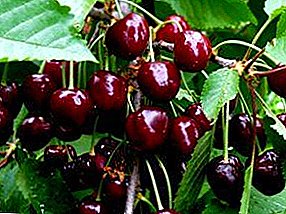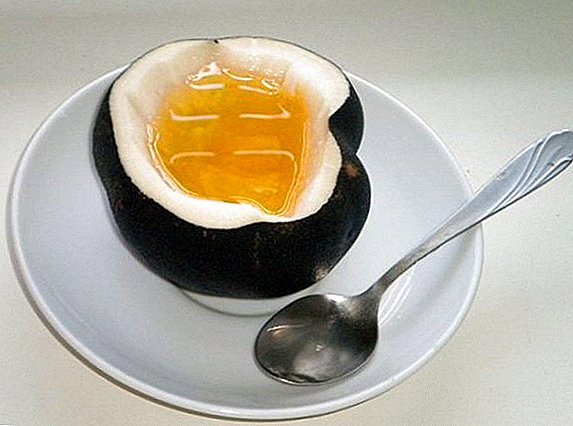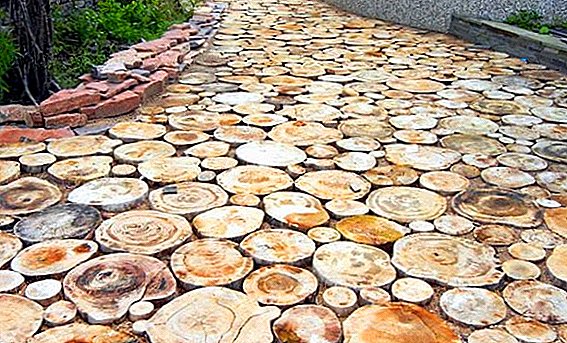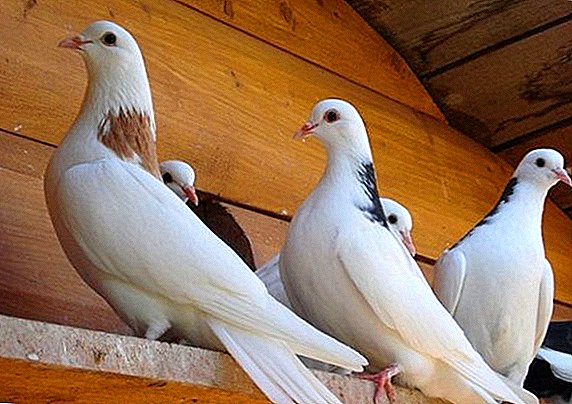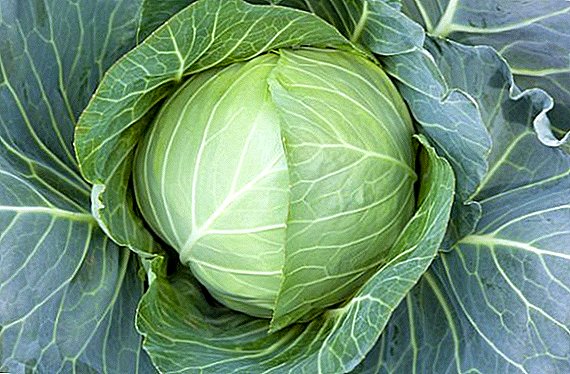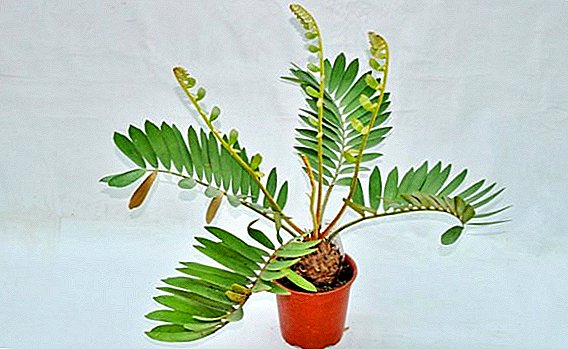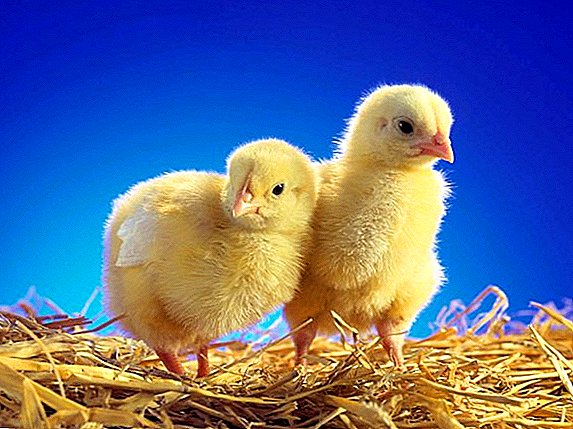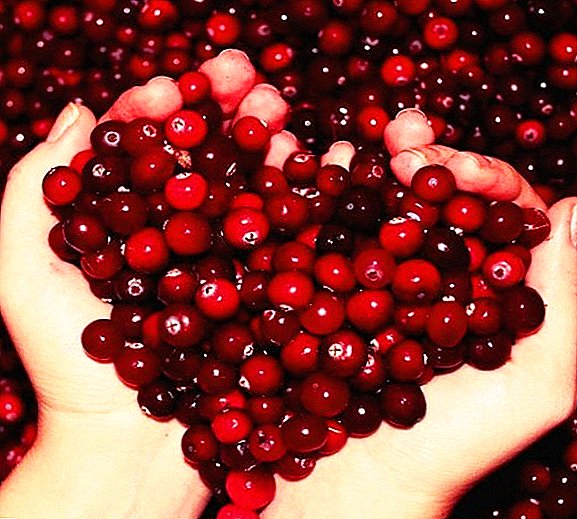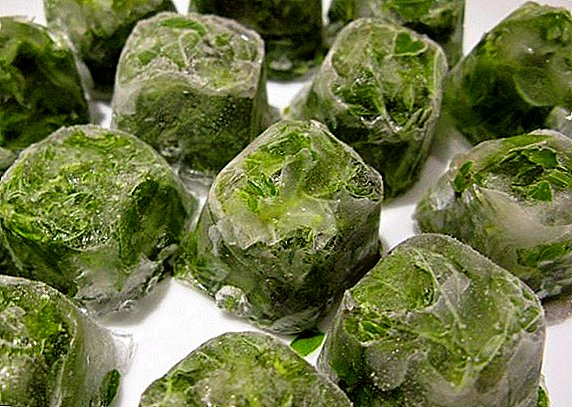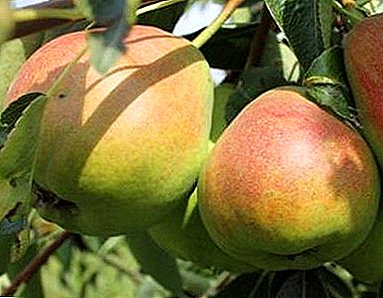
In the modern garden, created by the latest agricultural technology, there is always a place for large-fruited pears. They are very convenient for efficient agricultural production, aimed at maximizing yields of good-quality, tasty fruits.
One of these varieties that gardeners are often interested in is pear variety Bere Russkaya. This is a bright representative of the whole family of pear varieties, the name of which contains the French word "Bere".
All of them are united by one fundamental sign - oiliness of melting pulp in the mouth (the French word beurre translates as "butter").
What kind is it?
 Pear Bere Russkaya refers to late autumn-winter varieties. According to the biological "calendar", the ripening of fruits, allowing them to be removed from the tree, occurs approximately in mid-September.
Pear Bere Russkaya refers to late autumn-winter varieties. According to the biological "calendar", the ripening of fruits, allowing them to be removed from the tree, occurs approximately in mid-September.
It should be noted that the fruits of this variety, as well as other late varieties, are not recommended to be removed earlier than the specified period. Experts advise to give the fruit to ripen on the tree.
Otherwise, there is a risk of losing their taste. By the way, that ripe pears can spontaneously crumble from the branches until the moment of removal, you should not worry - stems firmly hold them in a tree.
As for consumer maturity - the period when pears retain optimal taste and commodity conditions, as well as the possibility of consuming them for food, it will last from October to the end of January.
For winter varieties include pears January, Yakovlevskaya, Chudesnitsa, Fairy, Nike.
According to the principle of fertilization, the Bere Russkaya variety is a classic self-infertile fruit plant. This category consists of garden crops, which are practically incapable of self-pollination by their own pollen.
Therefore, for normal fertilization, such a plant needs external pollinators - pear trees of other varieties, which bloom in the same period as the pollinated tree.
This pear is table variety dessert destination.
Breeding history and breeding region
 Bere Russkaya variety is a pear Voronezh selection. He was bred on the horticultural scientific and breeding base Rossoshanskoy fruit and berry experimental zone station (Rossosh, Voronezh region).
Bere Russkaya variety is a pear Voronezh selection. He was bred on the horticultural scientific and breeding base Rossoshanskoy fruit and berry experimental zone station (Rossosh, Voronezh region).
The author of a new pear variety has become Anna Mikhailovna Ulyanischeva - famous Soviet breeder.
Since the 50s of the last century, she continued the work of her father and mentor, the founder of the Rossoshansky station, Doctor of Agricultural Sciences Mikhail Mikhailovich Ulyanischev, under whose leadership dozens of new apple and pear varieties were developed on Voronezh land.
In order to get Bere Russkaya with its original properties, the author of the novelty crossed the "classic" Michurin winter variety. Bere winter Michurina (by now this pear has lost its production value and remained only in old gardens) with a Belgian autumn variety Forest Beauty.
Both parent cultures possess high yield, good winter hardiness and drought tolerance, which is very important for successful breeding in Russian regions with a temperate climate.
High yields are also demonstrated by the Cathedral, Rossoshanskaya Beautiful, Orlovskaya beauty, Autumn Yakovleva, Lyubimitsa Yakovleva.
In 1984, a new variety of pear was sent to the State variety testing. Zoned "Bere Russkaya" by Central Black Earth Region and Rostov Region.
Bere Russkaya variety description
This pear has its own specific external and structural features. The collective "portrait" of Bere Russkoy is as follows:
Tree
 The average tree is different medium size. The color of the bark that covers the stem of the plant can be either gray or light brown.
The average tree is different medium size. The color of the bark that covers the stem of the plant can be either gray or light brown.
Crown, branches. The adult individual has a broad, pyramidal top.
Skeletal branches to adulthood acquire a grayish-brown color. The density of the crown is characterized by medium or low density.
Shoots. Moderate thickness, straightened shoots are distinguished by a slight branching. On shoots that have a brownish-brown hue, there is some pubescence.
They are covered rarely located, small lentils. Buds on shoots awaken well. Fruiting pear occurs on kolchatka.
Leaves. The leaves are small in size. The form they resemble an egg, their tops are pointed. Slightly trimmed sheet "Bere Russkaya" is characterized by matte, with almost no gloss, the surface is dark green in color, with a characteristic bluish tinge. Leaves are kept on the tree by means of medium-long and thin stalks.
Inflorescences The flowers come out of the buds, having a white and pink color. The average saucer-shaped flower with beautiful white petals is small in size and has a noticeable aroma.
Several flowers are collected in umbrella-shaped, medium-sized brush. For pears Bere Russkaya characterized by early flowering.
Fruit
 The sizes of pears of this grade fluctuate medium to large.
The sizes of pears of this grade fluctuate medium to large.
As a rule, the mass of the fetus no lower than 140 g, the maximum weight was recorded at around 200 g. The fruits are round with a cone.
Dense, with a clear roughness of the peel is usually covered with dense erosiveness.
The main color of a ripe pear is golden yellow, on the part of the fruit it is a blurred dark red. There are barely noticeable small subcutaneous specks.
White with a creamy shade, the pulp is characterized by a soft, juice-rich consistency and considerable oiliness. Pear seeds are rather large, brown in color.
Fruits keep on a branch on sreddlinnye fruit stems. Appearance appeal by specialists estimated at 4.8 points (on a 5-point scale).
A photo

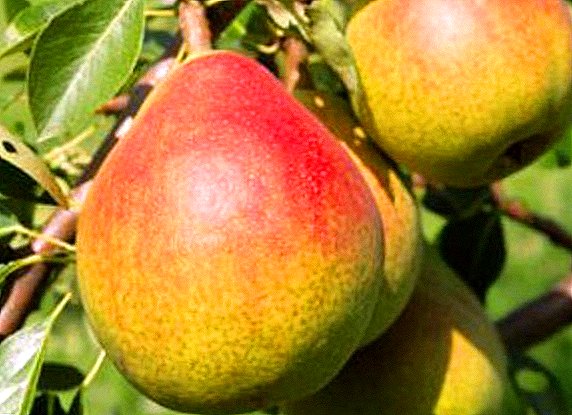



Specifications
According to the level of precociousness (the age of the fruit plant when it begins to bear fruit), the Bere Russkaya variety refers to medium pear species. Its first harvests tree begins to give from the age of 6-7 years.
It should be borne in mind that this precociousness is characteristic of the tree grown in Central Chernozem agricultural region. When planting a variety in areas with different climatic conditions, the precocity of Bere Russkaya may change.
In this region, the varieties are doing well: Hera, Carmen, Marble and Lada.
 In the gardens of the "native" region, trees of this variety show good yield. The averages of this parameter are at the level of 155-157 centners from one hectare.
In the gardens of the "native" region, trees of this variety show good yield. The averages of this parameter are at the level of 155-157 centners from one hectare.
In particularly favorable seasons, the yield can be many times greater, in any case, maximum yield was recorded at around 598 centners per hectare.
The obvious advantage of this pear is regular its high yields.
However, in a certain sense, the shortage of Bere Russkaya can be an obstacle to achieving maximum yields. its mid-level winter hardiness.
Tree does not tolerate frosts very well in the region of -30 - -32 ° Сthat is far from uncommon for central Russia. Therefore, gardeners cultivating this variety, recommend taking warming measures.
Sudden frosts during the flowering of pears are especially dangerous.
In particular, at the beginning of May 1999, in the Voronezh region, with a decrease in temperature to -5 ° C, 100% frosting of the inflorescences was recorded.
If the farmer regularly and accurately performs all the necessary protective measures, he can safely plan the industrial scale of cultivation of this fruit crop.
 This, in particular, contributes to a thick durable pear skin, due to which fruits can be stored in large quantities for a long time and safely transported to markets.
This, in particular, contributes to a thick durable pear skin, due to which fruits can be stored in large quantities for a long time and safely transported to markets.
To winter-hardy pear varieties include: Bere Bosk, Duchess, Northerner, Samara Beauty, Fairy Tale.
Pleases and sweet and sour taste of fragrant fruit (4.8 points tasting attractiveness).
The chemical composition of pear:
| Composition | amount |
|---|---|
| Sahara | 10,7% |
| Titrated acids | 0,25% |
| Vitamin C | 10.5 mg / 100 g |
Planting and care
Of great importance for the successful cultivation and exploitation of the tree is its planting. To protect the future harvest of late pears from frost, starting in mid-autumn, the choice of a windless part of the garden can.
Along with this factor, the landing site should be maximally illuminated by sunlight and not submerged by groundwater.
 To eliminate the danger of a destructive overmoistening of the root system, it is recommended to organize soil drainage in the area of seedling location.
To eliminate the danger of a destructive overmoistening of the root system, it is recommended to organize soil drainage in the area of seedling location.
At the selected point digging landing pit about 1 m deep and 65–70 cm in diameter. In the resulting hole is poured a bucket of water in which was dissolved 2 glasses of lime-fluff. Before the day of planting, the pit should be left for at least a week.
Planting trees is carried out in such a way that after filling its root system with earth (the soil before it is mixed with humus (2 buckets), sand (2 buckets) and a glass of superphosphate) the root neck protrudes from the soil to a height of 5-7 cm.
Near bore then watered with 2-3 buckets of water and mulch a layer of dried humus and sawdust.
Competent tree care implies regular watering plants, loosening near-stem garden, pruning too long branches, treatment from possible diseases.
Watch useful video tips on farming techniques:
Diseases and pests
The variety Bere Russkaya demonstrates high resistance to powdery mildew and scab.
Learn all about pear diseases: Bacterial burn, //selo.guru/ptitsa/bolezni-p/gribkovye/parsha.html, Rust.
However, in the epiphytotic seasons, when there is a large-scale invasion of fungal diseases on fruit trees, the described variety may be affected by Septoria.
 Septoria - A fairly common fungal disease of pears. When he defeats a tree, numerous grayish-whitish spots appear on the leaves, because of which this ailment got its second name - white spot.
Septoria - A fairly common fungal disease of pears. When he defeats a tree, numerous grayish-whitish spots appear on the leaves, because of which this ailment got its second name - white spot.
Usually the first painful spots appear in the last decade of May - in the beginning of June.
If you do not prevent the development of the disease, it leads to too early falling of the leaves and weakening the plant. As a result, the ability of a tree to resist frost deteriorates.
If preventive measures have not been taken on time, and the infection has occurred, the pear must begin to heal as soon as possible.
To do this, trees and soil are sprayed with nitrafen (300 g per 10 liters of water). This should be done in early spring, even before the buds begin to bloom.
With strict compliance with all agrotechnical requirements, Bere Russkaya variety will give the gardener a quality product that delights the consumer with exquisite taste.


